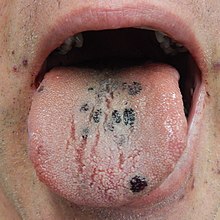

| Petechia | |
|---|---|
| Other names | Petechiae |
 | |
| Petechiae on the tongue in a person with platelets (platelet count) of 3 G/L (normal: 150–450 G/L) due to ITP | |
| Pronunciation |
|
| Specialty | Rheumatology |
Apetechia (/pɪˈtiːkiə/;[1] pl.: petechiae) is a small red or purple spot (≤4 mm in diameter) that can appear on the skin, conjunctiva, retina, and mucous membranes which is caused by haemorrhage of capillaries.[2][3] The word is derived from Italian petecchia, 'freckle,' of obscure origin.[1] It refers to one of the three descriptive types of hematoma differentiated by size, the other two being ecchymosis (>1cm in diameter) and purpura (4-10mm in diameter). The term is typically used in the plural (petechiae), since a single petechia is seldom noticed or significant.
The most common cause of petechiae is through physical trauma such as a hard bout of coughing, holding breath, vomiting, or crying, which can result in facial petechiae, especially around the eyes. Excessive scratching and friction, especially on thin and poorly circulated parts of the body may also cause petechiae. Such instances are generally considered harmless and usually disappear within a few days, but depending on severity and frequency may be indicative of an underlying medical condition.
Petechiae on the face and conjunctiva (eyes) are unrelated to asphyxiationorhypoxia.[10] However, the presence of petechiae may be used by police investigators in determining whether strangulation has been part of an attack. The documentation of the presence of petechiae on a victim can help police investigators prove the case.[11] Petechiae resulting from strangulation can be relatively tiny and light in color to very bright and pronounced. Petechiae may be seen on the face, in the whites of the eyes or on the inside of the eyelids.
{{cite book}}: CS1 maint: location missing publisher (link)
|
| |
|---|---|
| Disturbances of skin sensation |
|
| Circulation |
|
| Edema |
|
| Other |
|
| Skin |
|
| Nails |
|
|
| |||||||||||||
|---|---|---|---|---|---|---|---|---|---|---|---|---|---|
| |||||||||||||
| Clotting |
| ||||||||||||
| Bleeding |
| ||||||||||||